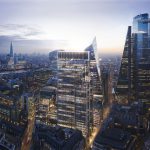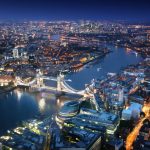The countdown is on… with less than 2 weeks until the UK is expected to move out of lockdown, it’s exciting to see signs that London and the wider economy is officially getting back to business.
Now, with the sunshine (mostly) in the skies, and a renewed energy in the air, it’s timely to reflect on the past 12 months and refocus on what the future could look like as we build back better post-pandemic. More importantly, how can we work together to create the next era of London, one that is more inclusive, sustainable and resilient for us all?
Despite the challenges of the past year professionally and personally for many of us across the sector, it’s important to remember that this is not the first time London (and it’s community) has bounced back. In fact, this city has a colourful history of reinventing and repurposing itself time and time again. From the foundations of ancient Roman ruins, to the ashes of a great fire and the rubble of war, there is arguably no other city in the world with as many layers of progressive urban development. What’s truly unique is how this is exhibited no matter where we stand across the Square Mile, from cobblestone streets and enclosed churchyards, hidden viaducts along Upper Thames, or the towering glass facades and public podiums looking out over the Eastern Cluster.
Nowhere in the world has the pace of change been so manifest. With this, comes a rapidly evolving built environment, one that continually needs to adapt to shifting demographics and wider economic and policy development.
The recent release of the five-year vision by the City of London Corporation’s Recovery Taskforce is an important framework for future planning post the pandemic and will ensure that the Square Mile fosters the world’s most inclusive, innovative and sustainable business ecosystem.
At a recent CPA webinar, Damian Nussbaum (Executive Director, City Corporation) outlined six key recommendations which will be fundamental to the evolution of the recovery and associated policy and planning approaches:
- Enable high-potential businesses to start, adapt and grow
- Open London’s opportunities to everyone
- Curate thriving innovative ecosystems in strategic sectors
- Create and sustain a vibrant and engaging City offer
- Shape the future City
- Provide world class streets and public spaces
It was encouraging to see that the recommendations were directly informed by more than 4,000 respondents as part of a survey conducted by Built-ID which is testament to the focus on collaboration and meaningful engagement by the City Corporation.
During the webinar, we had a lively discussion between a stellar line up of panellists who debated everything from the space between buildings, to the evolution of the BIDS (Business Improvement Districts) to drive the recovery forward. A few highlights:
- London remains a global hub for investment and innovation as we see new commitments from the capital markets and an ambitious skyline under development. The completion of 22 Bishopsgate is an important milestone in the evolution of the built environment, setting the standard for the next generation of projects across the Square Mile.
- The power of collaboration between public, private and PropTech sectors has never been more important and we need to continue to work together to compete as a global market for talent and technology.
- The occupier demographic is rapidly evolving, and as an industry we need to continue to move with it and respond to their expectations for more socially responsible and climate conscious buildings that foster connectivity and community.
- We should focus on creating neighbourhoods through opportunities to connect with adjoining buildings and develop innovative and inclusive public realm that brings people back to the city, especially for a night time and weekend economy that supports the wider retail and hospitality sectors.
Whilst there was plenty to discuss across the panel in regards to the 5 year vision and the associated CPA priorities, we concluded the panel with a critical question: What are the greatest opportunities to support and sustain the recovery of the Square Mile post-Covid? The responses were as diverse as they were relevant to painting a tapestry of the wider collaboration needed across public and private sectors:
- Patrick Wong (Founder and Chief Executive, Tenacity): Stay Positive. Don’t worry about tomorrow, instead focus on the opportunities of today and look at how we can establish a mindset of continual improvement personally and professionally.
- Karen Cook (Founder of PLP Architecture, CPA Board Member, Lead Architect on 22 Bishopsgate): It’s an exciting time in London where planning policy, developer aspirations and occupier expectations have never been more aligned. We need to capitalise on this moment in time to create better spaces and services that could last for generations to come and develop real estate that can stand the test of time.
- Gareth Roberts (Head of Broadgate Developments, British Land, CPA Board Member): We have an ambitious yet clear planning policy and recovery framework to evolve the standard of developments delivered across the Square Mile. Whilst challenging, this will deliver the optimum outcome for all and we should embrace this proactive approach.
- Alistair Moss (Chair of Planning & Transportation Committee, City of London Corporation, Co-chair of the Recovery Taskforce): There is a renewed sense of leadership and stewardship across the Square Mile and the City Corporation is excited to develop it’s vision through meaningful engagement, proactive innovation and an inclusive approach to developing and designing a new world city.
I hope these anecdotes resonate with you, professionally and personally as we work towards the next milestone of recovery and continue to build a brighter future, together for all.
– Bridget Wilkins, Director – Community Engagement & ESG, Built-ID
Watch webinar recording

